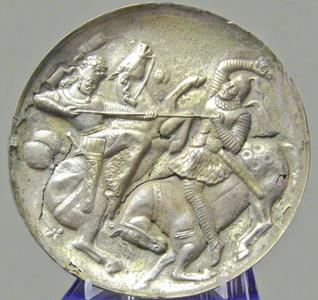
Cataphracts: Ancient Armoured Cavalry-Shaped Warfare
The cataphracts took part in many campaigns on the ancient war theatres in Eurasia and Northern Africa.
Both a cavalryman and a horse were completely covered in scale armour over chain mail, and a lance was the main weapon. These elite warriors were used for charges in order to break the defensive lines of the enemy.
From antiquity until the High Middle Ages, cataphracts were a very significant segment of warfare. Contrary to popular opinion, cataphracts influenced heavily armoured European knights whose units operated in the 14th and 15th centuries until the introduction of firearms.
The Byzantine Empire utilises the same military concept that was later on imitated in Western and Central Europe.
Different peoples and states deployed cataphracts during their military engagements: the Scythians, Sarmatians, Alans, Parthians, Achaemenids, Sakas, Armenians, Selucids, Attalid, Pontus, Sassanids, Romans, Goths, Byzantines, Georgians, Chines, Koreans, Mongols, Tangus, Jurchiens and Songhai.
In each military conflict warring sides try to copy the successful strategy and tactics of the opposing side. The fashion of heavily armoured Roman cavalry was a direct reflection of the successful Parthian and Sassanid campaign against the Roman and later Byzantine Empire.
The Roman cavalry was light but during the chaotic 3rd century AD, Romans adapted cataphracts, as Emperor Gallienus (ruled 253–268 AD) and his general and putative usurper Aureolus (died 268) arguably contributed much to the institution of Roman cataphract contingents in the Late Roman army.
The word cataphract comes from the Greek words κατά, a preposition, and φρακτός ("covered, protected"), which is interpreted along the lines of "fully armoured".
"Initially I wanted to investigate the 'eastern' influences on the military organisation of the Seleucid Empire because such a large empire had to have some influences from outside the Hellenistic world, " said a Dutch historian Ruben Modderman from the Leiden University, adding that it soon became apparent that this subject would be far too substantial
"The earliest classical source which lists cataphract cavalry explicitly is Xenophon, who lived in the 5th century BC. Overall, most early sources are written in Greek, while the later sources are mostly written by Romans in Latin," noted Modderman who studied Russian and Soviet historians and archaeologists.
Furthermore, the cataphracts evolved, adapting to changing circumstances and the need to keep up with enemy technology.
"This led ultimately to the only partially armoured cavalry horse and the rider clad in mail, who was then called clibanarius by Roman writers," Modderman explained, adding that the Romans distinguished the Persian cataphracts from their own by putting the noun equities in front. This noun was absent when they wrote about Parthian or Sassanid cataphracts.
The Finish military historian Ilka Syvanne maintains that the Parthians had had a long string of successes against the Macedonian combined arms forces before they came face-to-face with the Romans in the 1st century BC.
"They could therefore expect to win their battles when they faced forces that consisted of footmen [legionaries armed with the short pila] even more poorly equipped to face the cataphracts than were the Macedonian phalangites. The Romans had had a similarly long string of successes against a vast range of enemies, which even included armies [e.g. the Seleucids, Armenians, and Mithridates of Pontus] that possessed very significant numbers of horsemen equipped either as lightly-armed mounted archers or as cataphracts," Syvanne underlined.
Consequently, they too could expect to be able to crush these kinds of enemy forces, but what the Romans did not understand was the effectiveness of the Parthians mounted archery, but they soon did.
"The Roman advance in the east was effectively stopped by the Parthians at the famous battle of Carrhae in 53 BC. This has led some historians to think that in Parthians the Romans had met their match.
However, even if there is a germ of truth behind this claim, this is overstating the facts as already well noted by Adrian Goldsworthy. The Parthians were a powerful enemy, but they had serious weaknesses that prevented them from ever conquering the Roman East," Syvanne elaborated, adding that the Parthian Empire was possibly the first truly feudal society dominated by magnate families who enriched themselves through military expeditions, plunder, and land possessions.
These nobles/magnates were so powerful as to be able to challenge the king of kings with their armies. It was Surena's army of 10,000 horsemen retinue that cut Crassus' army to pieces at Carrhae, Syvanne noted.
Also, the Byzantine Empire and Eastern Europe were perceived by some as a periphery of the centre.
Also, the Byzantine Empire and Eastern Europe were perceived by some as a periphery of Central and Western Europe. However, that area was a territory where different influences merged from Western Europe, Mediterranean, and steppes, said a Serbian archaeologist, adding that Avars and Magyars brought with them different types of blades and swords.
"It's a misconception to connect heavily armed cavalry to Western Europe as it came from the Middle East," said archaeologist Milan Aleksic, author of the book" Mediaeval Swords from Southeastern Europe".
Cataphracts were one of the key factors for the Byzantine military dominance, Aleksic continued, adding that the Byzantine military literature from the 10th century testified on one of the cataphract units which numbered 503 horsemen.
They were set up in the form of a pyramid, and the first rows were armed with lances to penetrate the enemy's lines.
"Crusaders learned from not only Byzantines, but Muslim formations how to engage in the battle, but also they tried to study the types of swords, sables, and armoury," Aleksic underscored, noting that arms are the segment of material culture that fastest goes from one culture to another.

Legal Disclaimer:
MENAFN provides the
information “as is” without warranty of any kind. We do not accept
any responsibility or liability for the accuracy, content, images,
videos, licenses, completeness, legality, or reliability of the information
contained in this article. If you have any complaints or copyright
issues related to this article, kindly contact the provider above.


















Comments
No comment